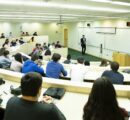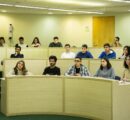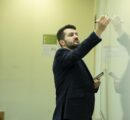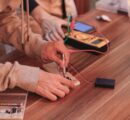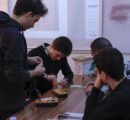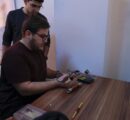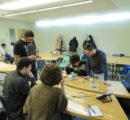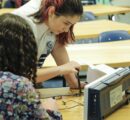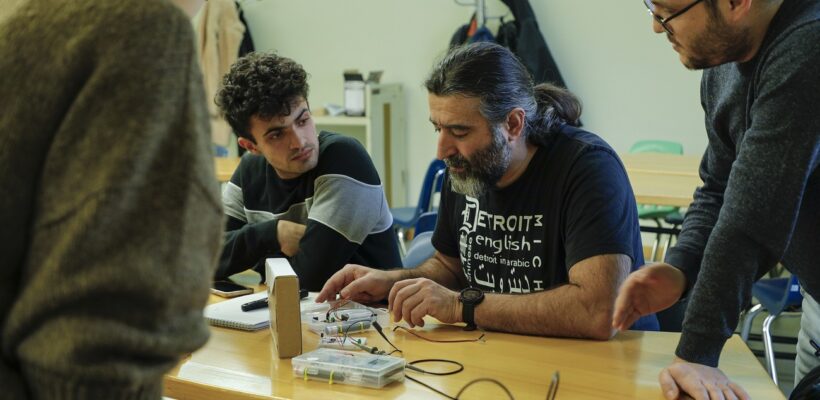
AUA-MIT Collaboration Realizes New Course Offerings
4 min readYEREVAN, Armenia — From January 9 to 27, the American University of Armenia (AUA) Akian College of Science and Engineering (CSE), in collaboration with the Massachusetts Institute of Technology (MIT) International Science and Technology Initiative (MISTI), organized a series of lectures to bring specialized topics to engineering enthusiasts. Flagship Pioneering Founder and CEO Dr. Noubar Afeyan expended great effort into the successful expansion of the collaboration between AUA and MIT by engaging some of the brightest minds from MIT to share their knowledge and research expertise with students in Armenia.
The first course in this exceptional series was about “Approximate Methods for Analytic Calculations” taught by MIT Ph.D. student Khachatur Nazaryan. Next were the courses in “Nuclear Detection With Geiger Counters,” taught by Grigor Tukharyan, Jaron Cota, and Armando Martinez, students at the Department of Nuclear Science and Engineering at MIT, and “Electrons and Invisible Photons” with Dr. Areg Danagoulian, professor at the department of Nuclear Science and Engineering at MIT. The courses covered subject matter in nuclear physics, optoelectronics, and analytic calculations, introducing various Armenian university and high school students to new topics to investigate in the broad field of engineering sciences.
Approximate Methods for Analytic Calculations by Khachatur Nazaryan
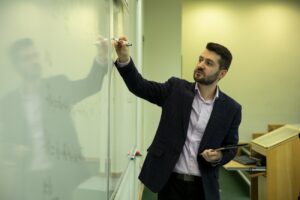 Khachatur Nazaryan is a first-year Ph.D. student at the Department of Physics at MIT. He graduated from the Moscow Institute of Physics and Technology with a bachelor’s degree in physics with first-class honors. His main area of research is condensed matter and atomic, molecular and optical (AMO) physics.
Khachatur Nazaryan is a first-year Ph.D. student at the Department of Physics at MIT. He graduated from the Moscow Institute of Physics and Technology with a bachelor’s degree in physics with first-class honors. His main area of research is condensed matter and atomic, molecular and optical (AMO) physics.
The course taught by Nazaryan attracted 24 students from AUA and other Armenian universities and schools, including Yerevan State University, Yerevan State Medical University after Mkhitar Heratsi, PhysMath School after A. Shahinyan, “Quantum” college, among others. The objective of this course was to equip students with the basic knowledge of and proficiency in handling approximate analytical calculations. Many physicists employ these techniques in their daily work, but they are rarely covered in traditional courses, making it impossible for students to participate in research that uses those techniques. “I was really impressed by the students’ enthusiasm. Many of them were coming to the lectures more than half an hour before class to discuss the hometask problems, which they were not even required to solve. Such devotion to education, combined with their strong potential, will lead these students to the top of their respective fields,” remarks Nazaryan.
Nuclear Detection With Geiger Counters by Grigor Tukharyan, Jaron Cota, and Armando Martinez
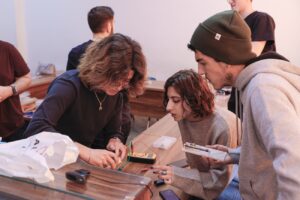 Currently enrolled in a master’s program at MIT, Grigor Tukharyan (BSES ‘22) received his bachelor’s degree in engineering sciences from AUA. His current research focuses on the use of proton accelerators to transmute and mitigate long-lived fissile nuclear waste. Jaron Cota is into fusion energy and is currently conducting research on molten salt materials that will aid fusion reactor development. Armando Martinez did his research on nuclear materials pertaining to fusion and is primarily interested in fusion energy.
Currently enrolled in a master’s program at MIT, Grigor Tukharyan (BSES ‘22) received his bachelor’s degree in engineering sciences from AUA. His current research focuses on the use of proton accelerators to transmute and mitigate long-lived fissile nuclear waste. Jaron Cota is into fusion energy and is currently conducting research on molten salt materials that will aid fusion reactor development. Armando Martinez did his research on nuclear materials pertaining to fusion and is primarily interested in fusion energy.
The three-week course comprised lectures and lab sessions. In the theory segment, students gained a basic understanding of nuclear interactions with photons, learned relevant concepts in statistics that are vital for nuclear detection, explored the analog electronics required to make a Geiger counter, and mastered the techniques of analyzing data using Python. Lab sessions were primarily for putting the knowledge gained into practice by having students build a Geiger counter by hand using analog electronics and breadboards and perform experiments with their own Geiger counters. Radiation sources and shielding materials were then analyzed using the student-built Geiger counters, integrating knowledge gained from theory into practice.
Electrons and Invisible Photons by Professor Areg Danagoulian
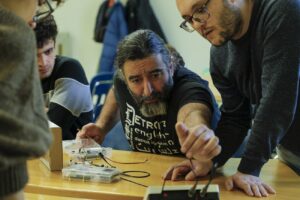 Professor Danagoulian did his Ph.D. in experimental nuclear physics at the University of Illinois at Urbana-Champaign, then worked as a postdoctoral researcher at Los Alamos National Laboratory. Subsequently, he spent five years as a senior scientist at Passport Systems, Inc. prior to joining MIT’s faculty. Dr. Danagoulian’s current research focuses on nuclear physics applications in nuclear security, areas such as nuclear nonproliferation, technologies for treaty verification, nuclear safeguards, and cargo security.
Professor Danagoulian did his Ph.D. in experimental nuclear physics at the University of Illinois at Urbana-Champaign, then worked as a postdoctoral researcher at Los Alamos National Laboratory. Subsequently, he spent five years as a senior scientist at Passport Systems, Inc. prior to joining MIT’s faculty. Dr. Danagoulian’s current research focuses on nuclear physics applications in nuclear security, areas such as nuclear nonproliferation, technologies for treaty verification, nuclear safeguards, and cargo security.
During the first week of the “Electrons and Invisible Photons” two-week course, students were introduced to the basics of electronics, optics, and optoelectronics. Through lectures and lab sessions, topics covered included the principles of laser physics and laser applications, both in civilian and defense contexts. Upon completing the theory classes, students set about creating the prototype of a simplified seeker by first instrumenting a photodiode, then measuring IR absorption, and ultimately building a sensor that can detect pulsed IR laser under a wide range of environmental circumstances. Dr. Danagoulian notes, “It is a huge joy to work with Armenian students. They are hard-working and very curious. The course is not easy — it is highly compressed and requires a lot of work, both in and out of the classroom. Out of about 25 students who started the course, about 10 persevered to the end. Those who did, learned a lot and developed great theoretical and experimental skills.”
The rewarding outcomes resulting from the AUA-MIT collaboration will lead to more initiatives yet to be implemented.
Founded in 1991, the American University of Armenia (AUA) is a private, independent university located in Yerevan, Armenia, affiliated with the University of California, and accredited by the WASC Senior College and University Commission in the United States. AUA provides local and international students with Western-style education through top-quality undergraduate, graduate, and certificate programs, promotes research and innovation, encourages civic engagement and community service, and fosters democratic values.

